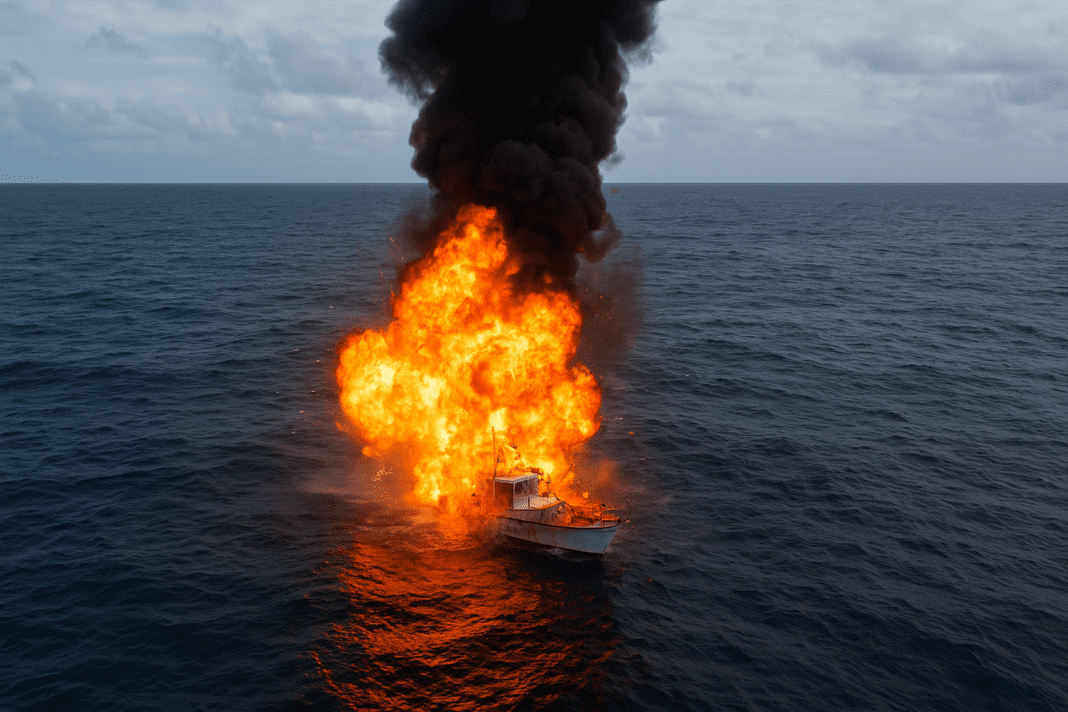The United States military has carried out its third fatal strike this month on a boat suspected of drug trafficking in international waters near South America. According to official statements, the latest operation resulted in the deaths of three people on board the vessel.
Third Fatal Drug Trafficking Operation in September
Officials ordered the strike as part of a wider military campaign in the region. They stated that the vessel operated along a route known for drug trafficking and that a designated terrorist group controlled it. The officials described the suspected smugglers as “narcoterrorists” and classified the strike as a “lethal kinetic action.”
After the operation, authorities released aerial video footage showing the boat traveling across open waters before a massive fireball suddenly engulfed it. They confirmed that US forces did not suffer any injuries during the mission.
Drug kingpin ‘El Mencho’ rises as cocaine floods America at lowest prices in years
This latest incident followed two earlier strikes in September. The first, on September 2, left 11 people dead, while the second earlier in the week killed three more. All three strikes have taken place in waters under the responsibility of the US Southern Command, which oversees operations in Central and South America.
Shift in Counternarcotics Strategy
The series of military strikes represents a sharp change in how the United States is handling drug trafficking in the region. In previous years, coastguard ships usually stopped suspected trafficking vessels. They detained and questioned the crews, and authorities followed up with legal action. The military generally limited its role in such cases to gathering intelligence and conducting surveillance.
Now, officials have shifted the approach from interdiction to directly destroying vessels believed to carry illicit cargo. They argue that traditional searches and arrests of drug trafficking boats have failed to deter smugglers. By striking the vessels outright, they aim to send a stronger message.
Patrick O’Hearn Sentenced to 15 Years in Prison for Drug Trafficking and Money Laundering
To support this campaign, the United States has significantly increased its military presence in the Caribbean and surrounding waters. Reports indicate that commanders have deployed eight warships, including guided-missile destroyers, a cruiser, and an amphibious assault squadron. A nuclear-powered fast attack submarine also operates as part of the fleet. Thousands of military personnel work alongside these ships during the mission.
Additionally, the United States has moved ten advanced fighter jets to Puerto Rico to strengthen aerial operations. This deployment has added to the visibility of US power in the region and has fueled concerns among neighboring countries.
Rising Tensions Linked to Drug Trafficking
The strikes have not gone unnoticed by other nations in the area. Regional governments have reacted strongly to the growing US military presence. Exercises and shows of force have been announced in response, highlighting the rising tension in Caribbean waters.
Military drills in the region have included thousands of troops, more than a dozen naval ships, and over twenty aircraft. Fighter jets of Russian design have also been displayed in recent exercises, underlining the scale of the preparation.
Officials from neighboring states have described the US deployment of warships and advanced aircraft as threatening. Some leaders have gone as far as to claim that the build-up is a cover for attempts at regime change. In speeches, they have spoken of large groups of militia being ready to resist in case of an invasion.
The latest strike on Friday continues a series of military actions that have transformed drug trafficking operations into high-profile military campaigns. While the exact locations of each strike have not been fully disclosed, earlier operations this month were said to target cartels linked to Venezuela.
The situation in the region remains tense as warships, submarines, and fighter jets continue to operate in close proximity to national forces conducting their own drills. For now, the confirmed fact is that three deadly strikes have been carried out in September, leaving a total of 17 people dead on boats accused of drug trafficking.

